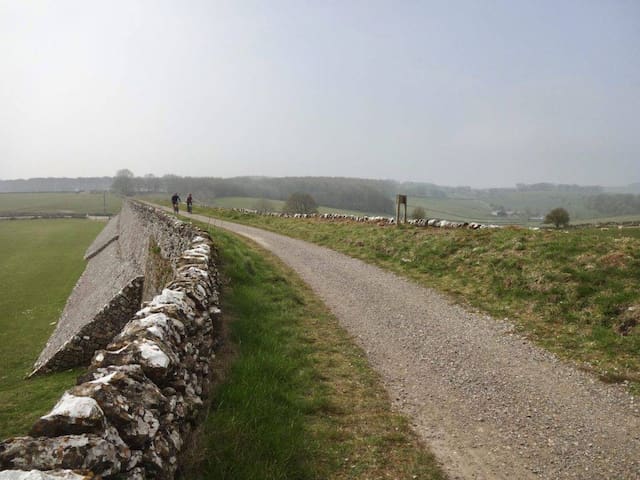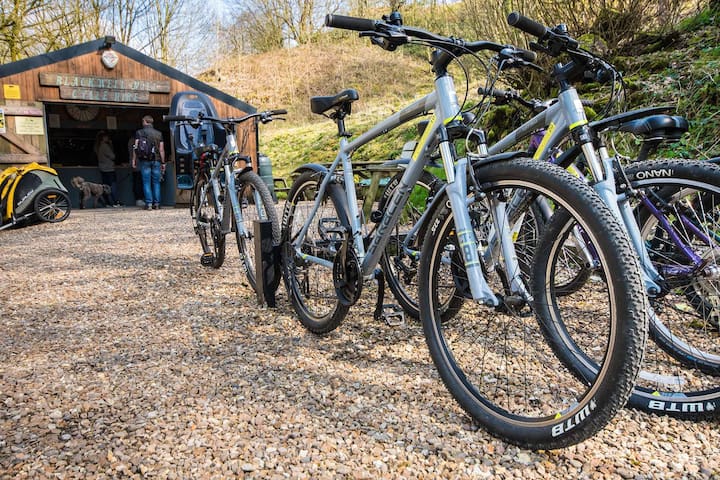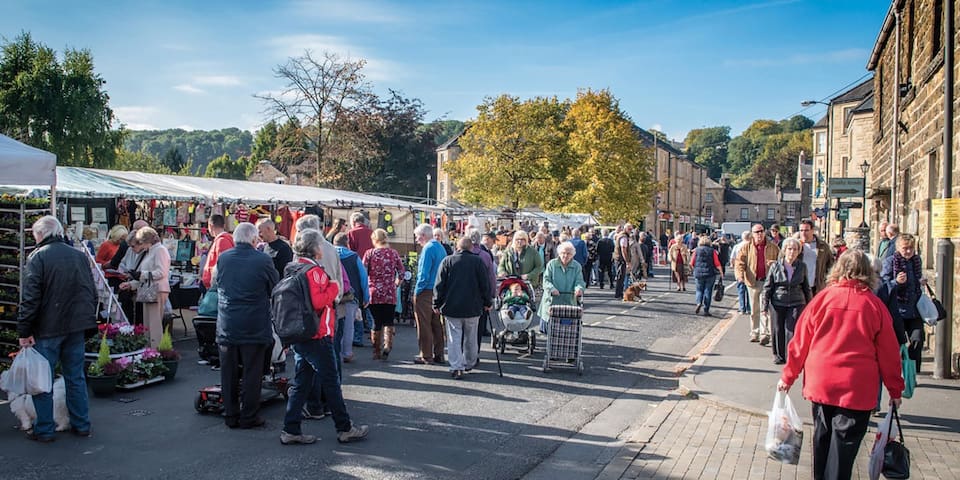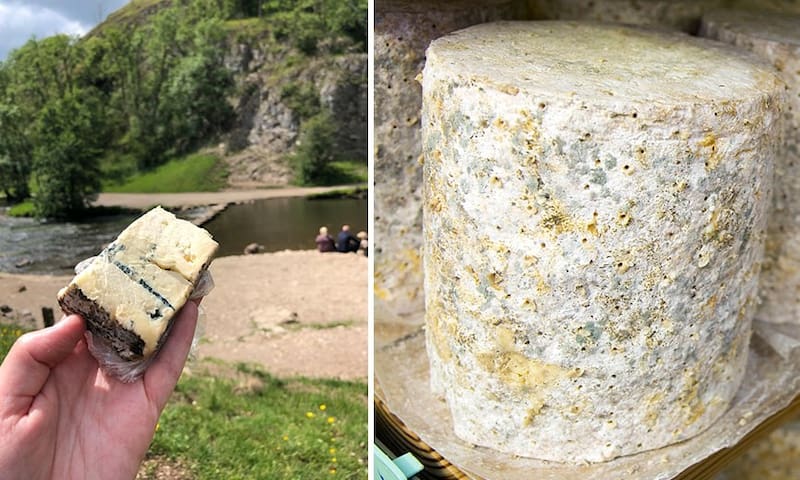Stately Homes
In 2018 this world-famous stately home completed its largest restoration for two centuries. Sixteen generations of the powerful Cavendish family (the Dukes of Devonshire), have lived at Chatsworth since 1549. Facing the hills from the east bank of the Derwent, this house is stuffed full of precious art, furniture, ceramics and Ancient Egyptian artefacts. The building itself has been altered down the years to suit its residents, and while its exterior is mostly Neoclassical from the 19th century, you can see older 17th-century Baroque elements on the eastern facade.
Also from this time are the Painted Hall and the Chapel, two of the least altered rooms in the house. The Devonshire Collection has paintings by Rembrandt, Gainsborough and John Singer Sargent, as well as drawings by Old Masters, invaluable metalwork, ceramics, Enlightenment scientific instruments and 18th-century furniture.
698 localnici recomandă
Casa Chatsworth
In 2018 this world-famous stately home completed its largest restoration for two centuries. Sixteen generations of the powerful Cavendish family (the Dukes of Devonshire), have lived at Chatsworth since 1549. Facing the hills from the east bank of the Derwent, this house is stuffed full of precious art, furniture, ceramics and Ancient Egyptian artefacts. The building itself has been altered down the years to suit its residents, and while its exterior is mostly Neoclassical from the 19th century, you can see older 17th-century Baroque elements on the eastern facade.
Also from this time are the Painted Hall and the Chapel, two of the least altered rooms in the house. The Devonshire Collection has paintings by Rembrandt, Gainsborough and John Singer Sargent, as well as drawings by Old Masters, invaluable metalwork, ceramics, Enlightenment scientific instruments and 18th-century furniture.
Built in stages between the 13th and 17th centuries, Haddon Hall is a splendid country house on the Wye a couple of miles from the centre of Bakewell. This was a residence for the Dukes of Rutland, and is held as arguably the finest surviving Medieval manor house in the UK. One reason so little has changed is that Haddon Hall was abandoned for 200 years until it was made habitable again in the 1920s. You’ll tour the interior, stepping into the atmospheric old kitchen and the banquet hall, which has a massive table that has never been moved from this location. There’s a wonderful parterre and walled topiary garden outside, with breathtaking views of the Peak District. With so much genuine period character, Haddon Hall has been chosen shooting location for movies like The Princess Bride (1987), Elizabeth (1998) and Jane Eyre (2011).
260 localnici recomandă
Haddon Hall
Built in stages between the 13th and 17th centuries, Haddon Hall is a splendid country house on the Wye a couple of miles from the centre of Bakewell. This was a residence for the Dukes of Rutland, and is held as arguably the finest surviving Medieval manor house in the UK. One reason so little has changed is that Haddon Hall was abandoned for 200 years until it was made habitable again in the 1920s. You’ll tour the interior, stepping into the atmospheric old kitchen and the banquet hall, which has a massive table that has never been moved from this location. There’s a wonderful parterre and walled topiary garden outside, with breathtaking views of the Peak District. With so much genuine period character, Haddon Hall has been chosen shooting location for movies like The Princess Bride (1987), Elizabeth (1998) and Jane Eyre (2011).
Sightseeing
On Wednesdays and Thursdays in summer you can discover this astonishing garden in the grounds of a large country house. Thornbridge Hall Gardens has recently become a Royal Horticultural Society “partner garden”, and was designed in a formal style in the 19th century. The man behind the garden, George Marples, wanted to be able to see “1,000 shades of green” from his bedroom window. In these 12 acres there’s a koi lake, rock garden, woodland, 30-metre herbaceous border, Italian garden and terraced lawns with a beautiful prospect of the Peak District countryside. Some of the statues here come from Chatsworth, while others were gifts from the Greek government.
25 localnici recomandă
Thornbridge Hall Gardens
On Wednesdays and Thursdays in summer you can discover this astonishing garden in the grounds of a large country house. Thornbridge Hall Gardens has recently become a Royal Horticultural Society “partner garden”, and was designed in a formal style in the 19th century. The man behind the garden, George Marples, wanted to be able to see “1,000 shades of green” from his bedroom window. In these 12 acres there’s a koi lake, rock garden, woodland, 30-metre herbaceous border, Italian garden and terraced lawns with a beautiful prospect of the Peak District countryside. Some of the statues here come from Chatsworth, while others were gifts from the Greek government.
In Bakewell you’ll be under the spell of the UK’s first ever National Park (1951). This southern portion of the Peak District is the White Peak, which comes from the white limestone geology of the region. This stone has been quarried for centuries, and if you travel the Monsal Trail, which we’ll talk about below, you’ll be able to see the underlying strata. The countryside around Bakewell is all drystone walls, heather moorland and dales awash with wildflowers in summer and speckled with grazing cows and sheep. At the Bakewell visitor centre in the handsome 17th-century market hall you can check out exhibitions about the Peak District and get hold of information on walking trails and sights in the White Peak.
73 localnici recomandă
Kinder Scout
In Bakewell you’ll be under the spell of the UK’s first ever National Park (1951). This southern portion of the Peak District is the White Peak, which comes from the white limestone geology of the region. This stone has been quarried for centuries, and if you travel the Monsal Trail, which we’ll talk about below, you’ll be able to see the underlying strata. The countryside around Bakewell is all drystone walls, heather moorland and dales awash with wildflowers in summer and speckled with grazing cows and sheep. At the Bakewell visitor centre in the handsome 17th-century market hall you can check out exhibitions about the Peak District and get hold of information on walking trails and sights in the White Peak.
Open March to November, this museum is in a 16th-century Yeoman’s house, a tithe (tax-collector’s home). The building was constructed in 1536 and enlarged later, in Queen Elizabeth’s reign as a gentleman’s residence. In the 18th century this building housed workers for Sir Richard Arkwright’s mills. The Old House has decoration and architecture from Tudor to Victorian times, furnished with grand fireplaces, wooden beams and walls of wattle and daub. You can see a display of period textiles, as well as tableaux showing Christopher Plant, the Tudor tithe collector at his ledger, and learn the story of the Bakewell Pudding in the kitchen.
The Old House
Cunningham PlaceOpen March to November, this museum is in a 16th-century Yeoman’s house, a tithe (tax-collector’s home). The building was constructed in 1536 and enlarged later, in Queen Elizabeth’s reign as a gentleman’s residence. In the 18th century this building housed workers for Sir Richard Arkwright’s mills. The Old House has decoration and architecture from Tudor to Victorian times, furnished with grand fireplaces, wooden beams and walls of wattle and daub. You can see a display of period textiles, as well as tableaux showing Christopher Plant, the Tudor tithe collector at his ledger, and learn the story of the Bakewell Pudding in the kitchen.
Step back in time in the atmospheric setting of Eyam, known to visitors and residents alike as the 'Plague Village'.
Immerse yourself in the incredible story of its unselfish villagers, who sealed themselves off from the outside world in the 17th century to prevent the deadly disease from spreading to neighbouring communities.
Trace the fascinating tale of how the Plague was brought to the White Peak village in a bolt of infected cloth from London in 1665, taking in key locations such as the church of St Lawrence, Plague Cottages, Cucklet Delf and - just outside the village - the Riley Graves and Mompesson's Well. You can also find out more at Eyam Museum, open from March to November.
In the heart of the village you'll find historic 17th century Eyam Hall, which was built just six years after the Plague subsided and was home to the Wright family for more than 11 generations.
Now managed by the National Trust, Eyam Hall is a fine example of a Jacobean manor house with its embroideries, engravings and library, plus walled garden with seasonal borders, vegetable plots and open, spacious lawns.
Next door you'll find a courtyard with a craft centre selling everything from Hartington cheese to handcrafted jewellery, while The Buttery serves light refreshments and lunch.
Opposite the hall are the village stocks, mainly used by Eyam's Barmote Court to regulate the wrong-doings of local lead miners.
The nearby church of St Lawrence dates back to Saxon times and has an original font and Norman pillars, thought to rest on Saxon foundations. The oldest and most striking feature of the churchyard is its eighth-century Celtic Cross. One of the best preserved examples of its kind in the country, it is decorated with a mixture of Christian and pagan symbols and may have once been a wayside preaching cross.
79 localnici recomandă
Eyam
Step back in time in the atmospheric setting of Eyam, known to visitors and residents alike as the 'Plague Village'.
Immerse yourself in the incredible story of its unselfish villagers, who sealed themselves off from the outside world in the 17th century to prevent the deadly disease from spreading to neighbouring communities.
Trace the fascinating tale of how the Plague was brought to the White Peak village in a bolt of infected cloth from London in 1665, taking in key locations such as the church of St Lawrence, Plague Cottages, Cucklet Delf and - just outside the village - the Riley Graves and Mompesson's Well. You can also find out more at Eyam Museum, open from March to November.
In the heart of the village you'll find historic 17th century Eyam Hall, which was built just six years after the Plague subsided and was home to the Wright family for more than 11 generations.
Now managed by the National Trust, Eyam Hall is a fine example of a Jacobean manor house with its embroideries, engravings and library, plus walled garden with seasonal borders, vegetable plots and open, spacious lawns.
Next door you'll find a courtyard with a craft centre selling everything from Hartington cheese to handcrafted jewellery, while The Buttery serves light refreshments and lunch.
Opposite the hall are the village stocks, mainly used by Eyam's Barmote Court to regulate the wrong-doings of local lead miners.
The nearby church of St Lawrence dates back to Saxon times and has an original font and Norman pillars, thought to rest on Saxon foundations. The oldest and most striking feature of the churchyard is its eighth-century Celtic Cross. One of the best preserved examples of its kind in the country, it is decorated with a mixture of Christian and pagan symbols and may have once been a wayside preaching cross.
Visit Cromford Mills for a complete day out, the start of your journey exploring the Derwent Valley Mills World Heritage Site. Discover more about this unique valley in the new Gateway with interactive displays with film and meet Sir Richard Arkwright himself in the “Arkwright Experience” Presentation by Sir Richard Arkwright on his Mills (Hologram) and video film, narrated by Brian Blessed, on the Derwent valley Mills World Heritage Site.
Take a narrow boat ride along the canal or accompany one of our guides as they bring the extraordinary history to life on a tour of the area. There are plenty of walks, trails, galleries, shops and places to eat to keep the whole family entertained. Look out for Family Fun Days, Arts and Crafts and other special events.
Cromford Mill is the world's first successful water powered cotton spinning mill and acclaimed throughout the world as being the first, complete factory system. Enjoy a guided tour, available every day.
67 localnici recomandă
Moara Cromford
Mill RoadVisit Cromford Mills for a complete day out, the start of your journey exploring the Derwent Valley Mills World Heritage Site. Discover more about this unique valley in the new Gateway with interactive displays with film and meet Sir Richard Arkwright himself in the “Arkwright Experience” Presentation by Sir Richard Arkwright on his Mills (Hologram) and video film, narrated by Brian Blessed, on the Derwent valley Mills World Heritage Site.
Take a narrow boat ride along the canal or accompany one of our guides as they bring the extraordinary history to life on a tour of the area. There are plenty of walks, trails, galleries, shops and places to eat to keep the whole family entertained. Look out for Family Fun Days, Arts and Crafts and other special events.
Cromford Mill is the world's first successful water powered cotton spinning mill and acclaimed throughout the world as being the first, complete factory system. Enjoy a guided tour, available every day.
Walking & Cycling
Bakewell is at the end of a fantastic 8.5-mile walking and cycling trail on the route of the old Manchester, Buxton, Matlock and Midland Junction Railway. The line was founded in 1863 to create a rail link between Manchester and London, and was shut down in 1968. The route ends, or starts, just east of Bakewell at Coombs Road, and what makes it such a treat is the amount of railway architecture to be found on the route. You’ll ride or walk past former stations, over viaducts and through six tunnels, four of which are so long they have to be lit during the daylight hours.
The Headstone Viaduct is a real highlight, spanning one of the most beautiful dales in the Peak District.
9 localnici recomandă
Monsal Trail - Cressbrook
Monsal TrailBakewell is at the end of a fantastic 8.5-mile walking and cycling trail on the route of the old Manchester, Buxton, Matlock and Midland Junction Railway. The line was founded in 1863 to create a rail link between Manchester and London, and was shut down in 1968. The route ends, or starts, just east of Bakewell at Coombs Road, and what makes it such a treat is the amount of railway architecture to be found on the route. You’ll ride or walk past former stations, over viaducts and through six tunnels, four of which are so long they have to be lit during the daylight hours.
The Headstone Viaduct is a real highlight, spanning one of the most beautiful dales in the Peak District.
This walking and cycling route crosses the Peak District for 17 miles, passing just south of Bakewell. Part of the National Cycle Network, the High Peak Trail is on the trackbed of the former Cromford and High Peak Railway, established in 1831 to carry stone and minerals between the Cromford and Whaley Canals.
After the line closed, Derbyshire County Council purchased the a big chunk of the line and turned it into a trail, laying the path with crushed limestone, which makes it suitable for walkers of all ages.
Around Ladmanlow the trail reaches its highest point, at 386 metres above sea level, and although the views are phenomenal the going can be tricky in bad weather. About five miles from Bakewell, at Parsely Hay, the High Peak Trail intersects with the Tissington Trail, on another repurposed railway line.
33 localnici recomandă
High Peak Trail
High Peak TrailThis walking and cycling route crosses the Peak District for 17 miles, passing just south of Bakewell. Part of the National Cycle Network, the High Peak Trail is on the trackbed of the former Cromford and High Peak Railway, established in 1831 to carry stone and minerals between the Cromford and Whaley Canals.
After the line closed, Derbyshire County Council purchased the a big chunk of the line and turned it into a trail, laying the path with crushed limestone, which makes it suitable for walkers of all ages.
Around Ladmanlow the trail reaches its highest point, at 386 metres above sea level, and although the views are phenomenal the going can be tricky in bad weather. About five miles from Bakewell, at Parsely Hay, the High Peak Trail intersects with the Tissington Trail, on another repurposed railway line.
Blackwell Mill Cycle Hire Monsal Trail
Bakewell RoadLocal Market
A market has traded in Bakewell since 1330, and the tradition is kept alive at the Stall Market on Mondays at the Marketplace and Granby Road. Between 09:00 and 16:00 you’ll find more than 100 traders selling flowers, fruit and vegetables, freshly baked bread, toys, jewellery, fabrics, yarn, clothes and shoes, as well as food made on the spot. It’s the largest market in the Derbyshire Dales, and on the last Saturday of the month you can browse the wares of local producers at the UK’s second largest farmers’ market.
13 localnici recomandă
Market Place
Market StreetA market has traded in Bakewell since 1330, and the tradition is kept alive at the Stall Market on Mondays at the Marketplace and Granby Road. Between 09:00 and 16:00 you’ll find more than 100 traders selling flowers, fruit and vegetables, freshly baked bread, toys, jewellery, fabrics, yarn, clothes and shoes, as well as food made on the spot. It’s the largest market in the Derbyshire Dales, and on the last Saturday of the month you can browse the wares of local producers at the UK’s second largest farmers’ market.
Food scene
You’ll see this well-known sweet delicacy across the town.
The Bakewell pudding, with a pastry base, a layer of jam and a sweet egg and almond paste filling, has been around since the first decades of the 19th century and according to tradition was invented by accident at the White Horse Inn. Supposedly, the landlady ordered her cook to bake a jam tart, but rather than add the egg and almond to the pastry, it was poured on top and set like a custard in the oven. Four different establishments claim to own the original recipe, and the most frequented is the Old Original Bakewell Pudding Shop on The Square.
35 localnici recomandă
The Old Original Bakewell Pudding Shop
The SquareYou’ll see this well-known sweet delicacy across the town.
The Bakewell pudding, with a pastry base, a layer of jam and a sweet egg and almond paste filling, has been around since the first decades of the 19th century and according to tradition was invented by accident at the White Horse Inn. Supposedly, the landlady ordered her cook to bake a jam tart, but rather than add the egg and almond to the pastry, it was poured on top and set like a custard in the oven. Four different establishments claim to own the original recipe, and the most frequented is the Old Original Bakewell Pudding Shop on The Square.
Established in the grounds of Thornbridge Hall in 2005, this brewery moved to a new, modern facility on Bakewell’s outskirts in 2009. Thornbridge has been described as the UK’s first craft brewery and has garnered scores of awards over the last 15 years.
You can get to this riverside brewery on foot in ten minutes from the centre of Bakewell, for a 90-minute tour, to hear the history of the brand, find out about how Thornbridge selects its ingredients. In the brewhouse you can check out the large stainless steel vats and discover the intricacies of boiling, fermentation and maturation. At the end you can try three from a big range of cask, keg and bottled beers.
45 localnici recomandă
Thornbridge Brewery
Buxton RoadEstablished in the grounds of Thornbridge Hall in 2005, this brewery moved to a new, modern facility on Bakewell’s outskirts in 2009. Thornbridge has been described as the UK’s first craft brewery and has garnered scores of awards over the last 15 years.
You can get to this riverside brewery on foot in ten minutes from the centre of Bakewell, for a 90-minute tour, to hear the history of the brand, find out about how Thornbridge selects its ingredients. In the brewhouse you can check out the large stainless steel vats and discover the intricacies of boiling, fermentation and maturation. At the end you can try three from a big range of cask, keg and bottled beers.
It might be home to the smallest Stilton producer in the world but the Peak District village of Hartington packs a big punch in the cheese-making stakes. At one time, this tiny parish supplied a quarter of the world’s Stilton cheese!
Hartington’s proud history of cheese-making dates back to the 1870s, but after local cheese production ceased with the closure of the Hartington cheese factory in 2009, a small group of passionate cheese-makers and local business people formed Hartington Creamery. This dedicated group officially brought the craft of cheese-making back to the village in 2012, reviving the famous Hartington Blue Stilton in 2014. Hartington Creamery has since scooped numerous awards for its Stilton, Peakland Blue and Peakland White cheeses. At the picturesque Old Cheese Shop in Hartington village centre, you’ll find over 100 varieties of cheese ranging from the Dovedale Blue to adventurous pineapple and sticky toffee varieties. It’s also a great place to stock up on locally-made chutneys, biscuits, beers and wine.
9 localnici recomandă
The Old Cheese Shop
Market PlaceIt might be home to the smallest Stilton producer in the world but the Peak District village of Hartington packs a big punch in the cheese-making stakes. At one time, this tiny parish supplied a quarter of the world’s Stilton cheese!
Hartington’s proud history of cheese-making dates back to the 1870s, but after local cheese production ceased with the closure of the Hartington cheese factory in 2009, a small group of passionate cheese-makers and local business people formed Hartington Creamery. This dedicated group officially brought the craft of cheese-making back to the village in 2012, reviving the famous Hartington Blue Stilton in 2014. Hartington Creamery has since scooped numerous awards for its Stilton, Peakland Blue and Peakland White cheeses. At the picturesque Old Cheese Shop in Hartington village centre, you’ll find over 100 varieties of cheese ranging from the Dovedale Blue to adventurous pineapple and sticky toffee varieties. It’s also a great place to stock up on locally-made chutneys, biscuits, beers and wine.




